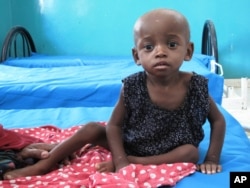In the 1990’s, as civil war wracked Somalia in the wake of President Mohammad Siad Barre’s ouster, a devastating famine killed thousands. The country is again experiencing severe drought, and the lack of the rain has increased malnutrition, especially among children. But much has changed in the past 20 years.
An assessment released Friday by the Food Security and Nutrition Analysis Unit (FSNAU) of the FAO says the failure of the seasonal rains in Somalia have severely affected cereal production, especially in the south.
A bumper crop during the last rains means the availability of food is not the primary concern, according to Grainne Moloney, the chief technical advisor for the FAO’s Food Security and Nutrition Unit for Somalia. Moloney said experts are most concerned about food prices.
“When we combine the last season plus the current season we actually have average levels of cereal in the country. So it’s not that the cereal availability is at an all-time low; it’s that the prices are going up,” she said.
“We see some of the major traders basically hoarding cereals and then releasing it because there’s such a high demand but at higher prices.”
The crop failure has also meant fewer opportunities for agricultural workers, said Moloney, “so they have less income to pay for food, calling it a ‘double whammy.’”
|
Grainne Moloney discusses the drought in Somalia |
But she said she believes the situation today is vastly different from the conditions that led to the famine in the early 1990s, during which 300,000 people died.
At the time Somalia had experienced several consecutive seasons of poor rains and drought. Moloney also blamed widespread looting and hyperinflation for the humanitarian crisis. But this year, she said, the previous rains exceeded expectations. In addition, she said, in 2010 Somalia recorded its highest-ever volume of exports, so there is money in the economy.
Moloney also said the improvement in the communications infrastructure in Somalia has made it easier to cope with food emergencies.
“All people have to do is pick up the phone and call a relative in Canada and within 20 minutes they’re getting money from a local money vendor,” she said. Moloney added that people can use their phones to “find out where the prices are best, find out where it’s safe to move.”
Moloney acknowledged that the lack of a central government and chronic insecurity still leaves people without the basic social support they need to weather a crisis. And she said it the lack of security is making it increasingly difficult for international NGOs to reach those in need.
However, she added, the international community has also become more sophisticated in monitoring and predicting crises over the past twenty years.
“The people would be in a better situation today, purely because there’s a lot more awareness of the situation; we have a lot more information. We knew that this was coming,” she said. “Agencies were scaling up because we knew there was going to be below-average rainfall.”












